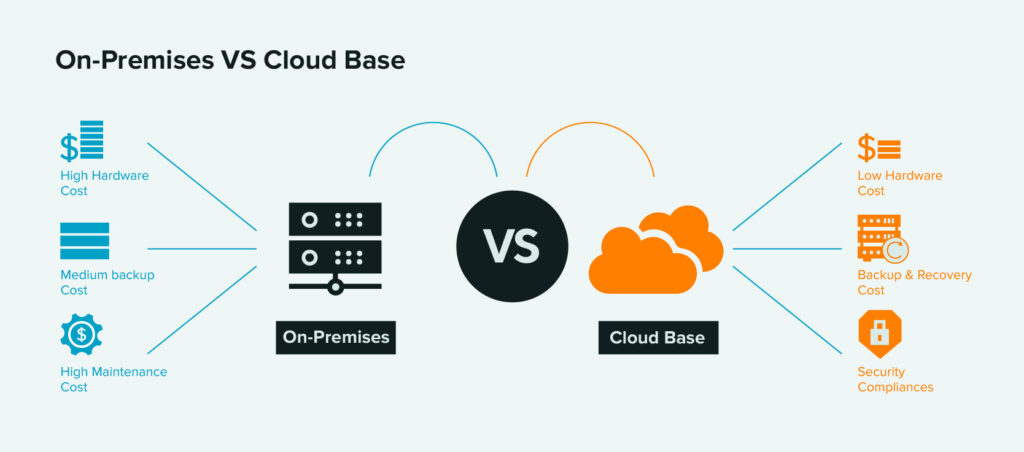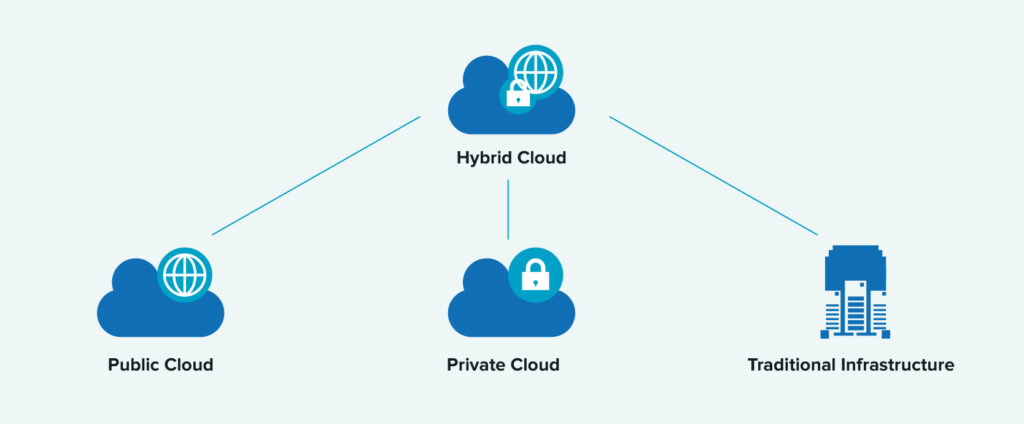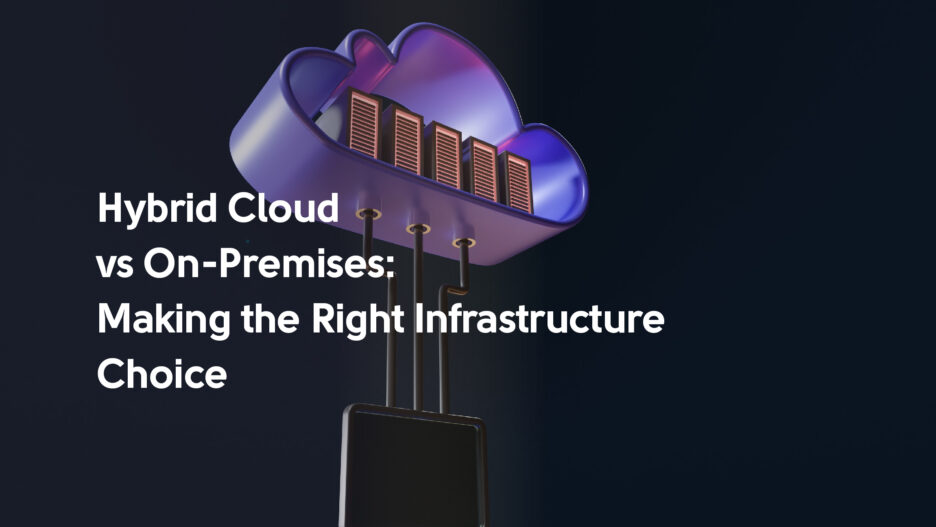VMware recently found that modernizing and integrating apps with public cloud services is a top priority over the next three years while Accenture reports that businesses can reduce Total Cost of Ownership (TCO) by up to 40% by migrating their operations to the public cloud.
It's important for organizations to dig deep and analyze their unique needs, expenses, and future objectives to make an informed decision. Are you up for the challenge?
Types of Infrastructures
On-Premises
Did you know that about 5% of cloud users plan to switch back to on-premises infrastructure? For all intents and purposes, on-premises infrastructure means that a company manages and takes care of all the hardware, software, and networking elements in its own building or data center.
It’s worth noting that maintaining on-premises infrastructure can be quite a task. You need a team of dedicated IT staff who are responsible for managing, monitoring, and maintaining the hardware and software components on a daily basis. Worth mentioning, maintaining hardware also entails costs of physical facilities like cooling, electricity, security guards, maintenance operators, and more. Essentially, organizations are responsible for crucial items like making sure all the hardware is set up properly, keeping all the software up to date, configuring the network, and making sure all the data is backed up and can be recovered if needed.
Additionally, on-premises infrastructure can be quite expensive. You'll most likely need to invest in hardware and software licenses, which can be a significant upfront cost. As such, organizations must effectively plan and allocate budgets to cover expenses like ongoing maintenance and operational costs.
Public Cloud
During and after the pandemic, companies worldwide have re-evaluated their infrastructure strategies, with many rapidly transitioning to cloud-based solutions. The shift towards a cloud-first approach has been further accelerated by the widespread adoption of remote work, with approximately 70% of organizations expediting their cloud migration in 2022.
Industry analysts at Gartner predict that by 2025, more than 85% of organizations will have adopted a cloud-first approach, and over 95% of new digital workloads will be deployed on cloud-native platforms. Fortinet's Cloud Security report highlights that cloud-based workloads already account for 75% in one out of five organizations, and it is projected that by 2023, 31% of organizations will run 75% of their workloads in the cloud.
These trends indicate a rapid and widespread adoption of cloud computing. Reports from Deloitte indicate that small and medium businesses using cloud technologies experience 21% higher profits and 26% faster growth. Migrating to the cloud also unlocks additional revenue streams, leading to significant profit growth year after year. Furthermore, Accenture's research reveals that migrating workloads to the public cloud results in cost savings of 30-40% in terms of Total Cost of Ownership (TCO).

Hybrid Clouds
According to research conducted by Virtana, over 80% of enterprises have implemented a multi-cloud strategy, while 78% of them utilize more than three public cloud platforms.
Further emphasizing the point, Cisco’s 2022 Global Hybrid Cloud Trends report found that an impressive 82% of IT leaders have embraced the hybrid cloud approach. Moreover, almost half of them (47%) are implementing two to three public infrastructure as a service (IaaS) clouds. Only a small fraction of organizations (8%) rely solely on a single public cloud provider.
The same Cisco report found that over half of the respondents (53%) indicate that they are regularly shifting workloads between on-premises and off-premises environments. It’s evident that hybrid clouds have emerged as a compelling solution because it brings together the best of both worlds: on-premises infrastructure and public cloud services. This means that organizations can indulge in having the security and control of their own infrastructure, while also taking advantage of the scalability and flexibility of the public cloud. It's a win-win situation.

Hybrid Cloud: Pros and Cons
Businesses often weigh the advantages and disadvantages of hybrid cloud vs on-premise deployments when deciding on the best infrastructure model for their company. Understanding the on-premise vs hybrid cloud pros and cons is the first step in making an informed decision that fits your business's needs and goals. Let’s review each in detail.
|
Advantages of Hybrid Cloud |
Disadvantages of Hybrid Cloud |
| Increased scalability: One of the best things about hybrid clouds is that they can add or remove resources on the fly. Organizations can use the flexibility of public cloud services to handle changing tasks. This way, they can get the best performance during times of high demand and save money during slower times. |
Complexity: Managing resources that are both on-premises and in the cloud can be hard in a hybrid setting. IT teams need to integrate data, place workloads, and use resources in the best way possible across different infrastructures. This may require more knowledge and management work. |
| Higher flexibility: With hybrid clouds, you can choose where to put workloads and apps based on your needs. Critical systems or private data can stay on-premises, which gives direct control and makes sure that regulatory requirements are met. At the same time, tasks that are not sensitive or that have changing resource needs can be moved to the cloud to take advantage of its scalability and wide range of services. | Data transfer costs: Depending on how much and how often data is moved between on-premises and the cloud, there may be data transfer costs. When planning their hybrid cloud approach and figuring out how to get the most out of their data flows, organizations need to think about these costs. |
|
Hybrid capabilities: Organizations can move workloads and data between different infrastructures and make them work together smoothly. This gives businesses the freedom to make the best use of their resources, choose the best environment for each task, and move slowly to the cloud. |
On-premises infrastructure: Pros and Cons
|
Advantages of On-Premises |
Disadvantages of On-Premises |
| Full control over data, security, and compliance: With on-premises infrastructure, companies have full control over their data, security measures, and compliance protocols. This level of control is especially important for businesses that have to follow strict rules or deal with very sensitive data. It ensures data sovereignty and reduces the risks that could come with cloud services. | High initial costs: Building and keeping an on-premises infrastructure requires a lot of money upfront to buy hardware, software licenses, networking equipment, and skilled workers. These start-up costs can be a problem for small businesses or businesses with limited resources. |
| Predictable costs: On-premises infrastructure costs are easier to predict because businesses own and control all of their hardware, software, and infrastructure parts. Even though there are starting costs, businesses that stay on-premises can avoid unexpected costs, such as data transfer costs or variable pricing models. | Maintenance efforts: Organizations with on-premises infrastructure are responsible for ongoing maintenance, which includes hardware changes, software updates, security patches, and infrastructure management. For this to work well, you need dedicated resources, knowledge, and a strong IT team. |
| Limited scalability: Scalability is limited with on-premises technology because of the way it is built. Organizations need to carefully plan and set aside resources to support future growth and scalability, which could require more investments in hardware and infrastructure expansion. |
Hybrid Cloud or On-Premises? Selecting the Best Infrastructure Solution
Now that we’ve gone over the clear pros and cons of each infrastructure type, let’s review in detail how to make the best decision for your unique project needs as there are a number of factors that need to be considered:
- Data sensitivity: Assessing the sensitivity of your data is paramount in making an informed decision. If your project involves highly sensitive or confidential information, on-premises infrastructure provides greater control and security, ensuring data remains within the organization's physical boundaries.
- Workload requirements: Consider the specific requirements of your workload. Hybrid clouds offer flexibility for workloads that exhibit variable resource demands or require burstable resources. By leveraging public cloud services, organizations can scale resources dynamically to meet fluctuating demands, optimizing performance and cost-efficiency.
- Budget: Evaluate your budgetary constraints and long-term cost considerations. On-premises infrastructure typically involves significant upfront investments in hardware, software licenses, and maintenance costs. Hybrid clouds, on the other hand, allow for a pay-as-you-go model, reducing upfront expenses and offering cost flexibility based on resource usage.
- Future growth plans: Assess your organization's growth plans and scalability needs. Hybrid clouds provide scalability and agility, enabling seamless expansion as your project and business demands evolve. Public cloud resources can be leveraged to accommodate sudden growth or new initiatives, while on-premises infrastructure may require additional investments to scale.
| Hybrid clouds are ideal for: |
On-premises infrastructures are ideal for: |
| Burstable resources: Hybrid clouds are ideal for workloads that experience variable resource demands. Organizations can leverage the scalability of the public cloud during peak periods while utilizing on-premises infrastructure for steady-state operations. | Data governance and regulatory requirements: Industries with stringent data governance and regulatory frameworks often prefer on-premises infrastructure. This option provides direct control over data security, privacy, and compliance measures, minimizing risks associated with third-party cloud providers |
| Compliance requirements: For industries with strict compliance regulations, a hybrid approach can offer the best of both worlds. Sensitive data can be kept on-premises to maintain control and meet regulatory obligations, while non-sensitive workloads can leverage the flexibility and cost-effectiveness of the cloud. |
Performance and low latency: Applications requiring consistent performance, low latency, or real-time data processing may benefit from on-premises infrastructure. By keeping data and computing resources in close proximity, organizations can achieve faster response times and better control over network latency. |
| Data localization: Hybrid clouds allow organizations to maintain sensitive data within their premises, addressing concerns related to data sovereignty and compliance with local data protection regulations. |
Unsure of Which Computing Option to Choose? Svitla Can Help!
Even though on-premises is suitable for some organizations, Svitla’s consultants have the expertise and know-how to define the most appropriate solution for each scenario.
Here are the specific ways Svitla Systems can help you choose what’s best for your organization:
- Svitla Systems has been assisting businesses in developing and implementing various solutions, including native cloud and hybrid infrastructures, for almost 20 years. We have the expertise to help you solve the complexities of hybrid clouds and on-premises infrastructure with expert consultation, needs assessment, solution design, vendor evaluation, implementation, and ongoing support.
- Svitla holds AWS Advanced Tier Partner status, confirming that we have a strong team of trained and certified cloud engineers and consultants with proven customer experience.
- Focus on prioritizing security with assessments and best practices in high compliance environments (e.g., HIPAA, SOC, PCI), safeguarding your cloud network and storage.
- Svitla Team of Cloud Consultants knows how to create detailed roadmaps for your cloud migration, ensuring a smooth and efficient transition. We also establish governance frameworks for proper management and compliance.
- Svitla provides comprehensive DevOps services, including setting up development and deployment pipelines, automating workflows, and integrating development and operations teams for efficient collaboration.
- Our experts help clients through the process of migrating data centers to the cloud, delivering a seamless transition. We also analyze your cloud usage and provide you with cost optimization strategies.
To further prove our capabilities, here’s a sample of case studies you can go through to conceptualize how our cloud expertise can align with your business needs:
Case in point: Sports Media Business aimed to transition their existing infrastructure to a new AWS environment. To accomplish this, Svitla Team meticulously planned and executed the separate migration of each website to an entirely new AWS infrastructure:
- Minimized Deployment Time and Elimination of Human-Factor Errors: eliminated manual interventions and human-factor errors, resulting in a 70% reduction in deployment time.
- Infrastructure Cost Reduction and Automatic Scaling: by using specific AWS solutions and automated scaling mechanisms, infrastructure costs were reduced by 50%.
Case in point: A leading provider of Spend Analysis Software sought to reengineer their entire solution, encompassing a revamp of the technology stack, a new architecture, and migration to the cloud. Additionally, they required support in scaling their onsite team for seamless development of the new solution.
- Full responsibility for migration: Svitla team took full responsibility for every step of the migration process, from creating new microservices to selecting the right tech stack and integrating the solution into AWS.
- Increased feature additions through Agile processes: Svitla’s Agile approach led to a remarkable 30% increase in the client's ability to add new features seamlessly and efficiently.
- Delivered an upgraded solution: delivered a revamped solution with a scalable architecture to accommodate future growth and increased user demands.
- Ongoing support and timely updates: delivered ongoing collaboration providing timely updates and adding new services.
Whether it's designing a seamless integration between on-premises systems and public cloud platforms or ensuring data security and compliance in a hybrid environment, the right partner will help you unlock the full potential of your IT infrastructure.
Contact us today for a profound consultation on which solution best suits your project.





![[Blog cover] SEO optimization best practices](https://svitla.com/wp-content/uploads/2025/05/Blog-cover-SEO-optimization-best-practices-560x310.jpg)